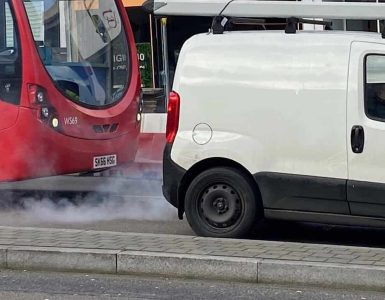Putney “3 school” school street Update
Update on the 29th June 2020
A big day as, thanks to some fab “community volunteers” from Extinction Rebellion in Putney, the first half of the school street is up and running and the kids are able to finish their journey to school with no cars.
Not only that the school street has extended round the corner into Clarendon Drive to the corner of Gamlen road after the Eileen Lecky clinic & the RSPCA hospital were consulted. This is a safer and more logical boundary for this end of the School street.
More good news is Wandsworth council hope to have official signage up & provide barriers later this week. Reaction from the schools, parents & residents has been all positive with a little curiosity mixed in!
Update on the 22nd June 2020
All 3 schools have now signed letters supporting the proposed school street and interim street closure for Covid distancing measures. These have been forwarded to Wandsworth council.
A 2nd council officer was appointed to work on this today but has not yet made contact.
The next challenge will be to accelerate the council’s definition of “urgent” to ensure that vital temporary barriers to allow safe distancing are in place promptly and well before the summer term end in mid July.
On the 5th June 2020 all 3 primary schools on Charlwood road gave verbal backing for a school street and an application has been made to Wandsworth council. In order to meet social distancing requirements Wandsworth council have been asked to provide temporary measures urgently to close the road at pickup and dropoff times while a school street is planned.
What is a school street?
The streets around a school temporarily become pedestrian and cycles only at set times in the morning and afternoon. Vehicles are not permitted to enter the street between these times unless they have been granted an exemption.
Operating times
- Operates on school days usually 30 minutes in the morning and 30 mins in the afternoon. eg 8.30am to 9am and 2.45 to 3.15
- School street does not operate during school holidays or weekends
The Details of operation ( recommended )

- All vehicles parked in a school street can leave without penalty
- You can register for an exemption if you’re a resident living or working in a school street zone, a business in a school street zone, or a blue badge holder
- School streets can only be introduced on minor roads where alternative routes exist for drivers. Tempting though it might be, schools on the south circular can’t have a school street to close it for drop off!
What does a school street setup involve
There are broadly 5 ways to set up a school street for both permanent and temporary school streets
1 Passive signage with no physical barrier or enforcement
- These are usually intended to be backed up by a temporary physical barrier but depend on school staff or parent volunteers to man them
- Used alone without a physical barrier it would be unfit for purpose as many drivers won’t see the sign and the children will have to avoid using the road anyway.
2 Active signage that drivers will notice but no barrier or enforcement



Essentially this is clear signage for motorists that should be effective without a physical barrier
- Larger signs clear to drivers at all entry points
- flashing lights to draw drivers attention
- the ability to adjust the timings and dates when the signs flash. For example if school hours change or during holidays.
- this gives option of not stating fixed operating times but instead saying it is operational whenever signs flash
- Different versions are adjusted by bluetooth or on the web
- While full time enforcement is not needed camera cars could be deployed if the need arises.
- the signs above are in use in in Edinburgh by several school streets & were produced by TWM Traffic Control Systems Ltd in Cheshire.
- we understand there may be legal issues about linking operation to “while lights flash” under English rules. Nevertheless having stated hours on passive “school street” signs and an additional flashing “school” sign on the same pole should be legal and have the required effect of bringing a drivers attention to the school street sign.
3. Temporary barriers
- Used for temporary or emergency street closures
- these are usually plastic barriers or cones kept at the school
- whenever need they are simply set up and then would be manned by teachers or parent volunteers
- these are the cheapest but most onerous for a school to manage as the signs have to carried out. set up, manned and then taken down 4 times a day.
4. physical pop up barriers

- These physically stop cars passing through
- Usually a pop out vertical post that raises into the road and prevents a vehicle passing the barrier.
- no enforcement required
- cheaper option is manual with a key.
- more expensive it a barrier that pops up and down automatically
- allowing access to residents or emergency vehicles is trickier
- Physical barrier prevents vehicles entering rather than letting them enter and fining them after they have already entered the school street
- Physical closure is much cheaper to install but requires school staff to raise and lower the barriers 4 times a day
5 Camera Enforcement
- Non-registered vehicles entering the street during the times of operation will be identified by camera and issued a fixed penalty notice
- this is the most expensive option but might encourage some to leave signage “unclear” to recover costs with fines rather than stop cars entering when schools have children arriving or leaving
- also means drivers will feel the road may be closed even during school holidays rather than risk a penalty
- cameras do have the advantage in reducing inconvenience to residents compared to a physical barrier and as a result could cut objections to the scheme.
Summary
- Physical barriers makes it clear to drivers if the school street is in operation that day – eg how would drivers know about school holidays on a camera unless signage indicates if operational
- Perhaps a flashing sign warning a school street is operating would be a good compromise and allows for police or camera car enforcement if breaches are an issue
Who can set up a school street
School streets are set up by local authorities after requests from schools and parents in their area. Local residents and businesses are also consulted before a school street can be implemented.
Other stakeholder include city mayors and Sustrans.
Where are existing school streets located
School streets were first introduced in the UK in Scotland from 2015. Since then several London Boroughs including Hackney have introduced them on a trial basis.
Is a school street anti car?
School streets are employed for short periods when far more people (children and parents and commuters) are on foot or bicycle than in vehicles.
It is a pragmatic way to allocate road space according to demand.- if 80% or more of the available width of a road is allocated to road surface and yet under 20% of the people users are in vehicles then road space should be allocated logically. Much the same happens already when roads temporarily close to allow fans to leave large sports events.
To get acceptance from residents and drivers the inconvenience has to be minimized. It should be clear at a glance whether the school street is in operation and they should never be in operation when not needed.
Goals – Safety and Health
School streets tackle congestion close to the school gates, making it easier and safer to walk scoot and cycle to school.
Encouraging healthy ways to get to school that don’t involve driving and promote exercise and healthy activity is a priority for children’s health. If children and parents feel the experience of getting to school is safe and relaxing it is more likely to become more popular.
Improving Air Quality for children on the way to school
Air quality refers to the air around us, how clean it is and how many pollutants (harmful chemicals or substances) it contains. The more pollutants the air contains the more air pollution there is and the worse the air quality is.
Children are one of the groups particularly vulnerable to the impacts of air pollution and many family cars are diesels which on average are over 10 times as polluting as even a petrol car. Air pollution:
- increases the risk of many respiratory and cardiovascular diseases including asthma
- reduces the lung development of children
- also increasingly being linked to a range of other conditions like bladder cancer, diabetes, dementia and birth defects.
The 3 school “School street” – an example proposal in Putney SW15
Putney in SW London falls under Wandsworth Council who have recently asked local schools if they would like to have a school street. 3 Schools have put themselves forward for one school street each. We hope this further proposal to join 3 primary schools with a single school street will also be considered. Wandsworth have provided an update on their plans here
The 3 primary schools joined by Charlwood road from North to South are
St Mary’s (Putney) Primary School, Felsham Road, SW15 1BA 250 pupils
Hotham Primary School, Charlwood Road, SW15 1P 390 pupils
Our Lady of Victories Clarendon Drive, SW15 1AW 210 pupils

Proposed school street
The 3 primary schools are on a road that is not a through route between lower and upper Richmond road because of a barrier already in place. Nevertheless enough vehicles drive up the road to prevent safe pedestrian use. There is more traffic between Felsham and Hotham road ( around 2 vehicles a min) and between Hotham and Clarendon around 1 vehicle every 2 mins.
Location of the proposed school street

The school street would be on Charlwood road, from Felsham road to Hotham road and then from Hotham road to Clarendon road. Traffic would continue to be uninterrupted on the cross streets of Felsham, Hotham and Clarendon drive.
Reasons for the 3 school “school street”
- 3 primary schools with 850 children aged from 41/2 to 11 years old are joined by this single artery but it is not a main road or a through route.
- in addition it is the main short cut between residents in west putney to Putney rail station for commuters on foot.
- for cyclists the road leads to the only railway crossing between Putney high street and Dryburgh road next to Putney leisure centre.
- the road is 2 way for traffic but so narrow that vehicles often have to mount the pavement in order to pass.
- there is no car parking on the street – all the houses have driveways
- The pavements are exceptionally narrow on both sides with no way to pass even a single buggy without stepping onto the roadway.
- Social distancing is impossible at busy times
- children on bicycles and scooters risk injury on the uneven surface over the pavements which raise and dip for driveways.
- The southern section to Our Lady of Victories has about 1 vehicle every 3 mins while the Northern section to St Marys has more traffic – probably 3 vehicles a minute with some mounting the pavement to pass each other.
- A very rough estimate would be that 10 times as many people use the road on foot or bicycle as are in the vehicles yet they occupy over 80% of the roadspace.
















[…] Friday the 5th June I put in an application for the “3 school” “school street” along Charlwood road in Putney. Having been a parent at Our Lady of Victories, I can remember the chaos of 850 primary children […]